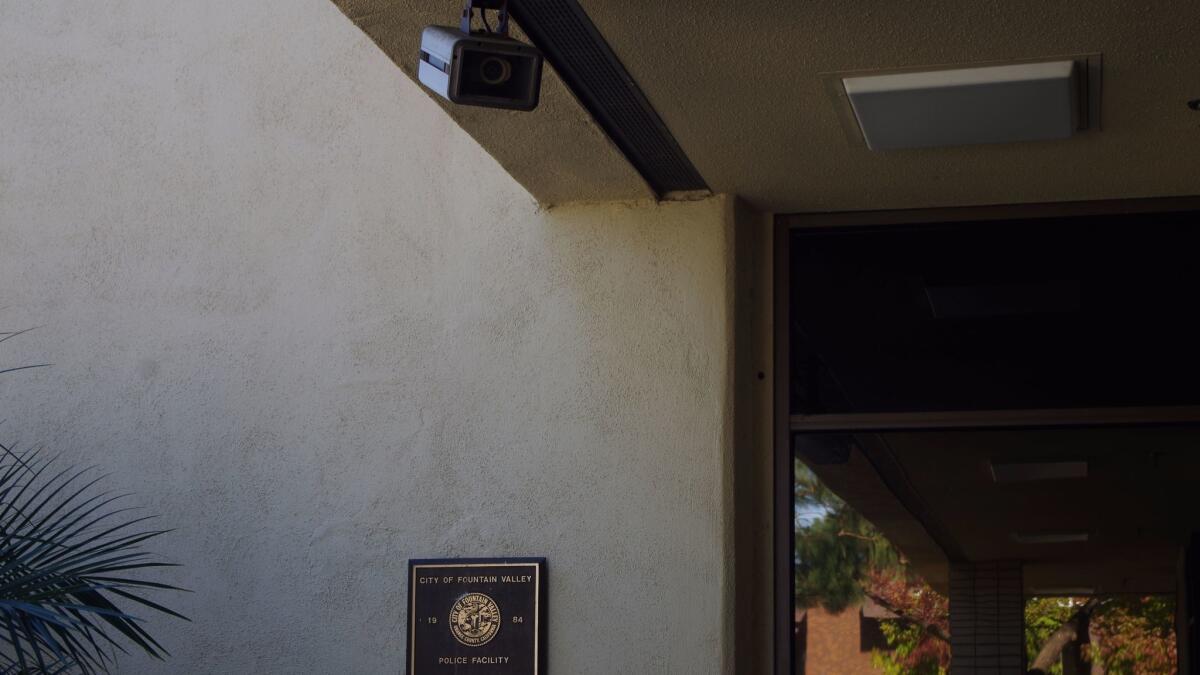Fountain Valley is ready to phase out its VHS security system

- Share via
The surveillance nerve center for the Fountain Valley Police Department suffers from partial paralysis.
Cameras stationed around the department, its jail and the adjacent City Hall feed footage to analog, multitrack VHS recorders that sit, unobtrusively but not with much dignity, behind a curtain in the police communications room.
The equipment has been there since 1998, and wasn’t cutting edge then, either — but a good deal, said Capt. Mike Simko, FVPD support services commander.
But now it costs about $15,000 to $20,000 a year just to buy enough 24-hour tapes — sometimes from eBay sellers — to record 24 hours a day, 365 days a year, and archive for at least a year, per state records retention standards.
That kind of upkeep makes less sense than joining the digital age, Simko said.
It’s time.
“Let’s get a modern system that actually has better video quality cameras, and we can actually protect the city,” he said.
That upgrade is in sight. The City Council agreed last week to spend about $180,000 on a modern, scalable digital system, which should be in place by late January or early February.
But until then, today’s needs are being met with equipment from the 1990s: four yellowing, gray VCRs, two of them operational; two decoders that make the analog video signals viewable; and two 8-inch, cathode-ray tube monitors, neither operational unless playing glowing ribbons of sometimes-identifiable scenes counts as functional.
The cameras that capture footage record at a rate of six frames per second and a resolution of 400 lines horizontal, roughly equivalent to 333 by 480 pixels.
By contrast — literally — a modern 4K TV has a pixel ratio of 3,840 by 2,160.
VHS. VCR. Cathode-ray tubes.
Audio? No. Color? Not exactly.
“It may be color but to be quite honest, when you’re viewing it, it really doesn’t look like it’s color,” Simko said.
The players — a less common version than the ones once ubiquitous in living rooms — have long been unavailable except occasionally online.
The cameras have fixed apertures, meaning they can’t adjust to extreme light. Identifying people and vehicles at night or in direct sunlight is nearly impossible.
And the jerky recordings expose the city to legal liability.
Simko said the police department found itself in such a position a few years ago, but had separate audio recordings as backup. (The new cameras will record at a rate of 15 frames per second.)
The equipment is prone to breaking and once down, can’t be repaired. When the department had three VCRs, it was able to dedicate one to playback and keep the two needed to cover the facility.
Then one of the machines broke. Now, to review footage, officers need to take one machine — and thus, half of its cameras — offline. (As the original monitors are useless, officers watch footage on a modern flat-screen, monochrome and pixelated as the images are.)
According to a staff report, Fountain Valley will spend $181,576.70 on a new system, taking about $81,000 from its capital replacement fund and about $100,000 from the proceeds of the local Measure HH sales tax, which supports public safety. Lake Forest-based Digital Networks Group will install the new system.
Fountain Valley Councilman John Collins said the cash-strapped city has had to support its police and fire operations by taking money out of other pots, including the capital fund.
“If we didn’t take that we probably would have had enough money in there to support this particular item,” he said Tuesday before voting to make the purchase.
The city identified improved security at City Hall and the police department as a priority in 2015. In January 2016, it put out a request for proposals.
But anemic funding, the standard review process and turnover in key leadership posts — including the city manager, police chief and finance director — kept the project mired down, Simko said.
The project was renewed when a new city manager came on board earlier this year.
Simko knows the security system is a relic. He’s not defensive about it.
He sighs.
“It is what it is.”
Twitter: @Daily_PilotHD
All the latest on Orange County from Orange County.
Get our free TimesOC newsletter.
You may occasionally receive promotional content from the Daily Pilot.




